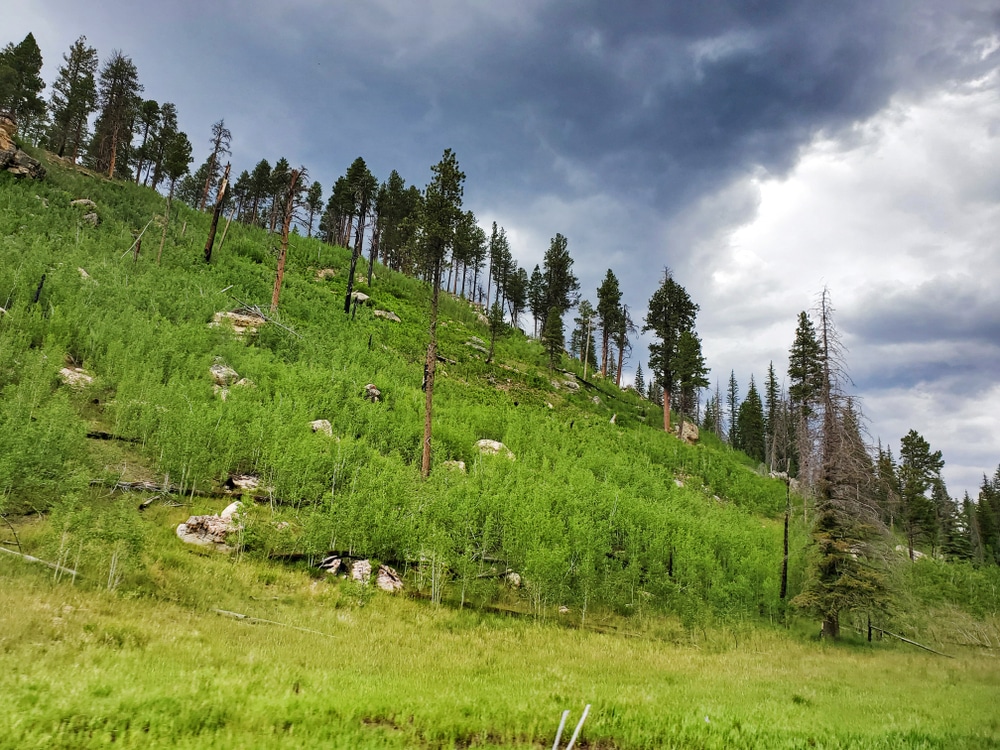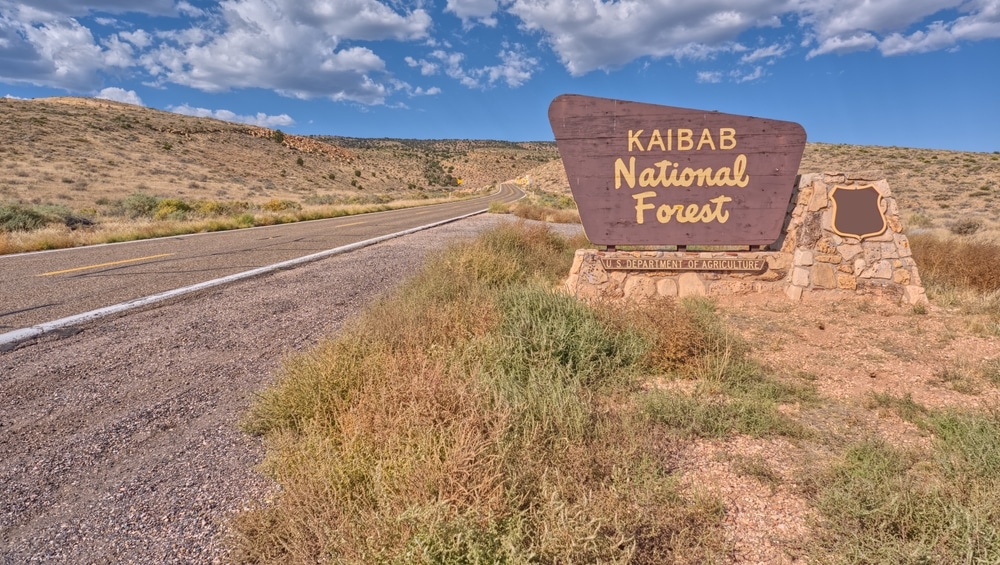The Kaibab National Forest stands as one of Arizona’s most remarkable natural treasures, encompassing approximately 1.6 million acres of diverse landscapes that surround both the north and south rims of the Grand Canyon. This expansive forest, whose name derives from a Paiute word meaning “mountain that lies down,” offers visitors an extraordinary array of experiences across its dramatically varying elevations, from desert landscapes at 3,000 feet to alpine environments soaring above 10,000 feet.
The forest is divided into three distinct ranger districts: the North Kaibab Ranger District (headquartered in Fredonia), the Tusayan Ranger District (near Grand Canyon Village), and the Williams Ranger District (based in Williams). Grand Canyon National Park separates the North Kaibab from the South Kaibab (comprising the Tusayan and Williams districts), creating two unique forest environments with different ecological characteristics and recreational opportunities.

Kaibab National Forest features several scenic routes that showcase the area’s stunning landscapes:
Mountain biking enthusiasts will love the trails in Kaibab National Forest, especially the Rainbow Rim Trail on the North Rim. Other biking opportunities include:
Williams District Trails: Numerous forest roads and trails are open to mountain bikers, offering a mix of terrain and scenery.
Tusayan Bike Trails: A network of trails near the South Rim, perfect for beginning and intermediate riders.

Kaibab National Forest is a hiker’s paradise, offering trails that range from easy nature walks to challenging backcountry adventures. Popular trails include:

Kaibab National Forest offers a mix of developed campgrounds and dispersed camping opportunities, allowing visitors to truly immerse themselves in nature. Popular campgrounds include:
For those seeking solitude, dispersed camping is allowed throughout the forest—just follow Leave No Trace principles.

Kaibab National Forest is home to several lakes and streams where anglers can enjoy fishing. Popular spots include:
Fishing licenses are required and can be purchased online or from local vendors.

Near the Wupatki Pueblo, you’ll find a unique geological feature called the blowhole, a natural vent in the earth that releases air due to underground pressure changes. Also nearby is a reconstructed ball court, which highlights the cultural connections between the Ancestral Puebloans and their Mesoamerican neighbors.

The diverse ecosystems of Kaibab National Forest support a variety of wildlife. Keep an eye out for:
The forest is especially active during early morning and evening hours.
Kaibab National Forest’s remote location and minimal light pollution make it an incredible spot for stargazing. On clear nights, you can see:

In the winter months, the higher elevations of Kaibab National Forest receive snow, creating opportunities for:

| Category | Details |
|---|---|
| Location | Northern Arizona, surrounding the Grand Canyon |
| Established | 1909 |
| Managed By | U.S. Forest Service |
| Size | Approximately 1.6 million acres (647,500 hectares) |
| Main Attractions | North Kaibab Plateau, Bill Williams Mountain, Sycamore Canyon Wilderness, and scenic drives |
| Ecosystem | Diverse ecosystems, including ponderosa pine forests, mixed conifer forests, desert scrub, and alpine meadows |
| Wildlife | Includes elk, mule deer, black bears, mountain lions, bobcats, and over 200 bird species |
| Districts | North Kaibab Ranger District (North of the Grand Canyon), Tusayan Ranger District (South of the Grand Canyon), Williams Ranger District (South of Tusayan, near Williams, AZ) |
| Recreation Activities | Hiking, camping, horseback riding, fishing, hunting, and scenic drives |
| Popular Trails | Arizona Trail (passes through the forest), Rainbow Rim Trail (offers stunning views of the Grand Canyon), Bill Williams Mountain Trail (a challenging hike to a summit) |
| Nearby Landmarks | Grand Canyon National Park, Vermilion Cliffs National Monument, and Flagstaff |
| Scenic Drives | Kaibab Plateau Scenic Byway (a drive through the North Kaibab Plateau), Route 66 (passes through Williams, AZ) |
| Climate | Varies by elevation: cool summers and snowy winters at higher elevations, hotter at lower elevations |
| Camping | Dispersed camping allowed; popular campgrounds include Jacob Lake, Ten-X, and Dogtown Lake |
| Accessibility | Visitor centers and some trails are wheelchair accessible |
| Entrance Fee | No entrance fee for the forest itself, but fees may apply at developed campgrounds |
| Fun Fact | The Kaibab National Forest is home to the largest ponderosa pine forest in the U.S., as part of the larger Coconino Plateau. |
The Kaibab National Forest spans a remarkably diverse geographic area with dramatic variations in elevation, topography, and ecosystems. These variations create distinct ecological zones that support a rich diversity of plant and animal life.
The forest is effectively divided into two sections by the Grand Canyon—the North Kaibab on the Kaibab Plateau north of the canyon, and the South Kaibab (comprising the Tusayan and Williams Ranger Districts) south of the canyon.
The North Kaibab encompasses the Kaibab Plateau, an “island” of forest surrounded by lower elevations. The plateau is bordered by the Grand Canyon to the south, tributary canyons of the Colorado River to the east and west, and a series of uplifted cliffs to the north. This isolated highland environment creates unique ecological conditions.
The South Kaibab includes diverse landscapes ranging from the edge of the Grand Canyon to the northern edge of the Mogollon Rim, which marks the southern boundary of the Colorado Plateau. This area features scattered mountain peaks, mesas, and rolling terrain.
Notable geographic features include:
The forest’s wide elevation range creates several distinct ecological zones:
Pinyon-Juniper Woodland: At lower elevations (5,500-7,000 feet), drought-resistant pinyon pine and juniper trees dominate the landscape, often interspersed with sagebrush, bitterbrush, Gambel oak, and cliffrose.
Ponderosa Pine Forest: The middle elevations (7,000-8,500 feet) feature magnificent stands of ponderosa pine, the dominant tree species in the forest. These tall, straight trees with reddish-orange bark create an open, park-like forest environment.
Mixed Conifer Forest: At higher elevations (8,500-10,000+ feet), the forest transitions to a mix of Douglas fir, Engelmann spruce, blue spruce, and aspen. These cooler, moister environments create habitat for different plant and animal communities.
Throughout these zones, meadows and open grasslands punctuate the forest, adding to the landscape’s diversity and providing important grazing areas for wildlife. Seasonal changes transform the forest dramatically, from spring wildflower displays to the golden hues of aspen groves in autumn and snow-draped pines in winter.
The diverse ecosystems of the Kaibab National Forest support an impressive array of wildlife, making the forest a premier destination for wildlife viewing and nature appreciation.
The Kaibab National Forest is home to an abundance of wildlife species adapted to its varied environments. Large mammals commonly seen include:
Other large mammals include mountain lions, bobcats, and coyotes, though these are more rarely encountered. Wild turkeys can be seen strutting through the forests, while golden eagles and various hawks soar overhead.
Smaller creatures abound as well. Abert’s squirrels, with their distinctive tufted ears, are a charismatic presence in ponderosa pine forests. Ground squirrels, chipmunks, porcupines, and numerous bird species add to the forest’s biodiversity.
For optimal wildlife viewing, visit during early morning or late afternoon when animals are most active. Popular wildlife viewing locations include forest meadows, water sources like lakes and tanks, and areas where different vegetation types intersect.
The Kaibab National Forest sits atop the Colorado Plateau, a vast region uplifted by geologic processes over millions of years. This elevation, combined with erosion from the Colorado River and its tributaries, created the dramatic topography seen today, including the Grand Canyon itself.
The North Kaibab’s isolation as a high plateau surrounded by lower elevations has led to interesting ecological adaptations. One famous example is the Kaibab squirrel, a subspecies of the Abert’s squirrel found only on the Kaibab Plateau. With its distinctive white tail and tufted ears, it’s a living example of isolated evolution.
The forest also contains evidence of recent volcanic activity. Red Butte, a prominent landmark south of Grand Canyon, is an erosional remnant capped by volcanic rock, standing as a sentinel to the region’s dynamic geological past.
The Kaibab National Forest offers a wealth of recreational opportunities for visitors of all interests and ability levels throughout the year. From hiking and camping to wildlife viewing and winter sports, the forest provides diverse experiences across its varied landscapes.
With over 300 miles of trails, the Kaibab National Forest is a paradise for hikers and backpackers. Trails range from easy interpretive walks to challenging wilderness routes. Some notable trails include:
North Kaibab District:
Williams District:
Tusayan District:
The forest offers numerous developed campgrounds as well as opportunities for dispersed camping:
Developed Campgrounds:
Most developed campgrounds feature picnic tables, fire rings, and toilet facilities. Some offer drinking water and can accommodate RVs up to 40 feet. Campgrounds typically operate from late spring through fall, with exact dates depending on weather conditions.
Dispersed Camping: Permitted throughout much of the forest, with some restrictions. Campers must stay at least 1/4 mile from water sources to protect wildlife habitat and at least one mile from developed recreation sites. Maximum stay is 14 days within a 30-day period.
Though the Kaibab National Forest has no natural lakes or year-round streams (except the Colorado River in the Grand Canyon), several man-made lakes provide fishing and limited boating opportunities:
These lakes are stocked with rainbow trout, and some contain brown trout, largemouth bass, and bluegill. A valid Arizona fishing license is required for anglers 14 years and older.
Winter transforms the Kaibab National Forest into a snow-covered playground, especially at higher elevations:
Winter recreation is weather-dependent, with the most reliable snow conditions typically occurring from December through March.
The Kaibab National Forest contains four designated wilderness areas that preserve some of the most pristine and ecologically significant landscapes in northern Arizona. These areas, protected by the Wilderness Act of 1964, are managed to maintain their “untrammeled by man” character, providing opportunities for solitude, primitive recreation, and the preservation of natural conditions.
Located in the North Kaibab Ranger District, this 68,000-acre wilderness encompasses the dramatic Kanab Creek Canyon, one of the major tributaries of the Grand Canyon. The wilderness is characterized by colorful cliffs, deep narrow gorges, and a complex network of side canyons. Hiking here is challenging but rewarding, with no maintained trails and rugged terrain requiring advanced navigation skills. The area borders Grand Canyon National Park to the south and Grand Canyon-Parashant National Monument to the west.
Also in the North Kaibab Ranger District, this 40,600-acre wilderness protects the eastern edge of the Kaibab Plateau. Elevations range from 6,000 to 8,000 feet, creating diverse habitats. The wilderness offers dramatic views of Marble Canyon and the Vermilion Cliffs to the east. Wildlife is abundant, including deer, turkey, and occasionally mountain lions. Several trails provide access, though some are primitive and require good route-finding abilities.
Straddling the boundary between Kaibab and Coconino National Forests in the Williams Ranger District, this 6,510-acre wilderness protects the slopes of Kendrick Mountain, northern Arizona’s second-highest peak. Three trails lead to the summit, where hikers are rewarded with panoramic views extending to the Grand Canyon. The wilderness contains diverse forest types, from ponderosa pine to mixed conifer and aspen stands.
Located partly in the Williams Ranger District (and extending into Coconino and Prescott National Forests), this 55,937-acre wilderness protects Sycamore Canyon, the second largest canyon system in Arizona after the Grand Canyon. Red rock walls, diverse vegetation zones, and riparian areas create spectacular scenery and important wildlife habitat. The wilderness can be accessed via the Sycamore Rim Trail, which skirts its edge, or more challenging routes that descend into the canyon itself.
These wilderness areas allow hiking, horseback riding, camping, hunting, and fishing, but prohibit motorized or mechanized equipment (including bicycles) and have restrictions on group sizes. They represent the most pristine environments within the Kaibab National Forest and offer exceptional opportunities for experiencing natural landscapes with minimal human impact.
The lands now comprising the Kaibab National Forest have witnessed thousands of years of human history, from ancient indigenous cultures to pioneer settlements and modern forest management. This rich cultural heritage adds depth to the visitor experience and provides important context for understanding the landscape.
Archaeological evidence indicates human presence in the Kaibab area dating back thousands of years. The Cohonina and Kayenta Anasazi (Ancestral Puebloan) peoples inhabited portions of the forest from approximately 700 to 1150 CE. These cultures left numerous archaeological sites throughout the forest, including stone houses, pit dwellings, and artifacts like pottery shards.
The forest remains significant to contemporary indigenous peoples, including the Havasupai, Hualapai, Kaibab Band of Paiute Indians, Navajo Nation, Hopi Tribe, and others. The name “Kaibab” itself comes from the Paiute language, meaning “mountain lying down.”
Many places within the forest hold cultural significance for tribal communities. The “Waters for Life” project represents a collaborative effort between the Hopi Tribe and the Kaibab National Forest to protect and restore natural seeps and springs that are Traditional Cultural Properties for the Hopi people.
European American settlement of the area began in the late 19th century, with ranchers, miners, and loggers drawn to the region’s resources. The town of Williams, now considered the “Gateway to the Grand Canyon,” was established as a railroad and lumber town.
In 1893, the Grand Canyon Forest Reserve was created, marking the beginning of federal management of these lands. In 1906, President Theodore Roosevelt designated the Grand Canyon Game Preserve on what is now the North Kaibab Ranger District, setting aside over 600,000 acres “for the protection of game animals and birds.”
The Kaibab National Forest was officially established in 1908, and in 1919, portions of the forest were redesignated as Grand Canyon National Park. In 1934, the Tusayan National Forest south of the Grand Canyon was consolidated into the Kaibab National Forest, forming the present forest boundaries.
Several historic structures in the forest provide glimpses into the past:
These sites connect visitors to the human stories that have unfolded across this landscape over generations.
Planning a successful visit to Kaibab National Forest requires understanding access points, facilities, regulations, and safety considerations. This section provides essential information to help you prepare for your journey.
The forest can be accessed from several directions:
North Kaibab Ranger District:
Williams and Tusayan Ranger Districts:
Most major visitor areas are accessible by paved roads, though many forest roads are unpaved and may require high-clearance vehicles, especially after wet weather.
Kaibab Plateau Visitor Center: Located at Jacob Lake at the junction of Highway 89A and Highway 67, this center provides information about the North Kaibab Ranger District and Grand Canyon National Park’s North Rim. Open seasonally, typically from mid-May through mid-October.
Williams & Forest Service Visitor Center: Located in Williams, this center offers information about the southern portions of the forest.
District Ranger Stations:
Many recreational sites within the forest require day-use fees, typically around $8 per vehicle. Annual passes are available, as are federal recreation passes like the America the Beautiful Interagency Pass.
Some activities require special permits:
The Kaibab National Forest experiences distinct seasons that affect accessibility and activities:
Summer (June-August): Peak visitation season with warm days and cool nights at higher elevations. Afternoon thunderstorms are common during the monsoon season (July-August).
Fall (September-October): Cooler temperatures and fall colors, particularly from aspen groves. Generally dry and stable weather makes this an excellent time to visit.
Winter (November-March): Snow can be heavy at higher elevations, especially on the North Kaibab. Many forest roads close, and facilities operate on reduced schedules. The North Rim access road (Highway 67) typically closes with the first significant snowfall, usually by mid-November.
Spring (April-May): Variable conditions with lingering snow at higher elevations and muddy roads during thaw periods. Wildflowers begin to appear, and wildlife becomes more active.
Fire restrictions: Frequently implemented during dry periods, typically from May through July before monsoon rains arrive. Always check current restrictions before planning campfires.
Weather preparedness: Mountain weather can change rapidly. Bring layers, rain gear, and appropriate footwear.
Water: Most areas lack reliable water sources. Bring ample water for all activities.
Navigation: Cell service is limited or nonexistent in many areas. Carry paper maps and inform others of your plans.
Wildlife awareness: Store food securely to avoid attracting bears and other wildlife. Be alert for potential encounters with larger animals.
The Kaibab National Forest faces numerous conservation challenges as it balances recreation, resource management, and ecosystem protection. Understanding these challenges helps visitors appreciate the importance of responsible forest use.
Several significant initiatives are underway to protect and restore forest ecosystems:
The Baaj Nwaavjo I’tah Kukveni—Ancestral Footprints of the Grand Canyon National Monument: Established to preserve important historic, cultural, natural, and scientific values of lands around Grand Canyon National Park, including portions of the Kaibab National Forest.
Waters for Life: A collaborative stewardship project between the Hopi Tribe and Kaibab National Forest focusing on protecting and restoring natural seeps and springs that serve as Traditional Cultural Properties.
Forest restoration projects: Efforts to restore forest health through thinning and prescribed burning, reducing wildfire risk and improving wildlife habitat.
Visitors can contribute to forest conservation through responsible practices:
By combining thoughtful management with visitor stewardship, the Kaibab National Forest can continue to provide outstanding recreational opportunities while preserving its ecological and cultural values for future generations.
The Kaibab National Forest stands as a testament to the remarkable diversity and beauty of northern Arizona’s landscapes. From its soaring pine-covered plateaus to its dramatic canyons, from peaceful mountain lakes to panoramic vistas of the Grand Canyon, this forest offers experiences that connect visitors with the natural world in profound ways.
Whether you seek adventure on wilderness trails, the tranquility of a lakeside campsite, glimpses of wildlife in meadow clearings, or simply a scenic drive through changing forest environments, the Kaibab provides “layers of opportunity for peace, solitude, and discovery.” Its accessibility from the Grand Canyon makes it an ideal complement to a national park visit, offering different perspectives and experiences of this magnificent region.
As you explore the Kaibab National Forest, take time to appreciate not only its natural wonders but also its cultural heritage—the stories of ancient peoples, pioneers, and forest stewards who have shaped this landscape through time. And remember that your own actions contribute to the forest’s future, as each visitor becomes part of its ongoing story.
The forest’s seasonal transformations ensure that no two visits are ever quite the same. Whether blanketed in snow, vibrant with spring wildflowers, lush with summer greenery, or painted with autumn gold, the Kaibab National Forest awaits your discovery in every season.
We use cookies to improve your experience on our site. By using our site, you consent to cookies.
Manage your cookie preferences below:
Essential cookies enable basic functions and are necessary for the proper function of the website.
Statistics cookies collect information anonymously. This information helps us understand how visitors use our website.
Marketing cookies are used to follow visitors to websites. The intention is to show ads that are relevant and engaging to the individual user.